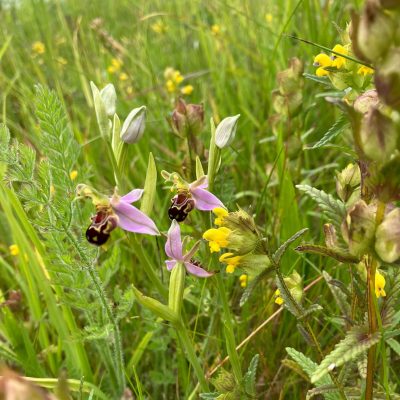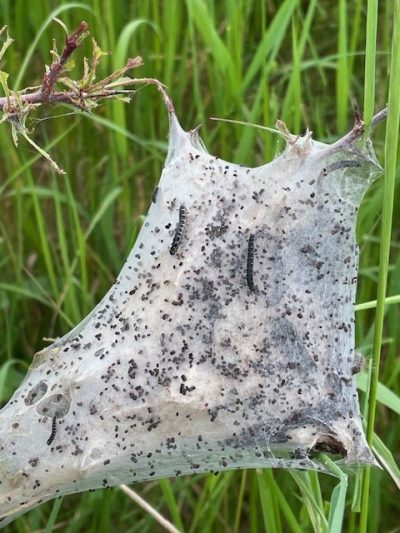On the cloudy but pleasantly warm morning of Monday 3 June, eleven of us met at Miles Gibson’s fruit farm in Westwell. Miles had invited us over for a guided walk during which we could learn about his organic techniques in growing fruit and we could help to identify plants and other wildlife.
The land has been in Miles’ ownership for about 20 years and much of it had been farmed organically before that. After gaining experience in organic farming methods, he began planting soft fruit, from which he makes a variety of liqueurs. He has a distillery on site.
Gradually, he extended the variety of fruit, creating new products, all of which are grown organically and without pesticides or synthetic fertilisers.
Before we got far on our tour, we were able to chat with an apiarist who had just collected honey from the hives near to the soft fruit. It was interesting to see the racks of honeycomb and to get his views on the merits of raising bees on organic sites as well as the perils of insecticides.


Our tour took in two main areas. The first was dedicated to growing soft fruit. Rows and rows of black, red and white currants and autumn raspberries are grown here, together with elder, the flowers of which are made into liqueur, and blackthorn for sloes. We were surprised to notice that there was no netting covering the bushes, the birds apparently preferring the nearby wild cherries and largely ignoring the soft fruit. The areas between the bushes are mown and underneath each is black lining and stones to protect against weeds. The ripe fruit is collected by hand by groups of volunteers.
The second, even larger area to the south of the fruit field has been planted for wild flowers. Each half is mown every other year, after ground nesting birds have fledged. To the left is an area that Miles wishes to leave altogether “to see what happens” (he is currently undertaking a rewilding course and using techniques derived from his studies). At the top of the field are four acres of native trees, planted about six years ago, all looking very healthy.

There was a glorious abundance of wild flowers and plants in the meadow, (the attached list will speak for itself), including lots of pyramidal orchids and really lovely bee orchids too. Yellow rattle, which was planted in a relatively small area has spread extensively and has allowed for the growth of many other flowers. Skylarks sang above us and a variety of insect life was all around too. It is a wonderful illustration of how organic management enhances natural habitats.
Very many thanks to Miles for a fascinating and really enjoyable visit.
Julia Reid 5 June 2024
The plant species list can be found here.
Birds seen or heard: Chaffinch, Dunnock, Song thrush, Swallow, Swift, Buzzard, Red kite, Skylarks.
Insects: Swollen-thighed flower beetles (male and female), Garden chafer, Cinnabar moth, Small-eggar caterpillars, brownish moth, small solitary bees, flies various.
There will be an Open Day at Westwell Fruit Farm on 17th August.
Notes: Nursery-web spiders, often found basking on nettles, eventually enclose their egg sacks in a web into which the spiderlings emerge and grow.
Small eggar moths are relatively uncommon. The caterpillars live in a tent on hawthorn and blackthorn hedges for two years and get destroyed by unsympathetic hedge cutting and flailing.
